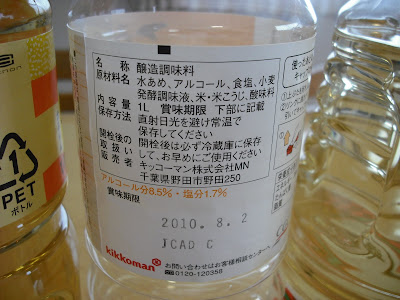In general, there are three types of mirin that are readily available in supermarkets in Japan: Hon mirin, hakko (jozo) chomiryo, and mirin-fu chomiryo.
今日は味醂(みりん)ついて少し話します。前から、日本の調味料について話したいと思っていましたが、みりんは日本料理独特のものなので、みりんから始めたいと思います。
一般的に、日本のスーパーですぐに手に入るみりんには3種類あります。本みりん、発酵(醸造)調味料、みりん風調味料です。




Left: Hon mirin
Raw materials: Mochi rice, rice, malt rice, jozo alcohol (distilled alcohol*), sugars
* Jozo alcohol is alcohol for brewing, but seems to be usually translated into distilled alcohol. Jozo alcohol is used in the process of making sake.
Alcohol content: 11.5 to 12.5%
Middle: Hakko (or jozo) chomiryo (fermented (or brewed) seasoning)
Raw ingredients: Mizuame (starch syrup), alcohol, salt, wheat fermented seasoning, rice/malt rice, acidic ingredients
Alcohol content: 8.5%
Salt content: 1.7%
Right: Mirin-fu chomiryo (mirin-like seasoning)
Raw materials: Mizuame (starch syrup), rice/malt rice brewed seasoning, brewed vinegar, acidic components
左: 本みりん
原材料: もち米、米、米こうじ、醸造アルコール*、糖類
*醸造アルコールとは醸造用アルコールのことですが、通常、distilled alcoholと訳されるようです。醸造アルコールは日本酒の製造過程で使われます。
アルコール分: 11.5度以上12.5度未満
中央: 発酵(醸造)調味料
原材料: 水あめ、アルコール、食塩、小麦発酵調味液、米・米こうじ、酸味料
アルコール分: 8.5%
塩分: 1.7%
右: みりん風調味料
原材料: 水あめ、米・米こうじの醸造調味料、醸造酢、酸味料
Of the three, only hon mirin is real mirin, while the other two are mirin-like products. Hon mirin is the most expensive, while mirin-fu chomiryo is the least expensive. Note that hakko chomiryo contains some salt to make it undrinkable (that is, to avoid liquor tax). You would hear people say, "Use hon mirin." I personally wouldn't say so. Reason? I can hardly tell the difference among the dishes made with them.
3つのうち、本みりんだけがみりんで、他の2つはみりんに似た製品です。本みりんが一番高価で、みりん風調味料が一番安価です。発酵調味料には、飲用できないよう(つまり、酒税を逃れるため)塩分が少し入っています。「本みりんを使え」と言う人が多いようですが、私自身はそうは思いません。理由は、どれを使って料理を作っても、その違いが殆ど分からないからです。
Anyway, hon mirin is said to have these six features:
1. Has a mild sweetness because it contains different types of sugars, such as glucose and oligosaccharide, whereas sugar has a strong sweetness because it is pure sucrose.
2. Gives the surface of the ingredients gloss and luster.
3. Keeps the ingredients from disintegrating, because of the sugars and alcohol contained in it.
4. Has deep body and umami due to the combination of the umami components, sugars, and other components produced from mochi rice.
5. The alcohol penetrates the ingredients quickly, making it easy for flavors to penetrate the ingredients.
6. Eliminates odor. The alcohol, which has penetrated the ingredients, takes the odor away when it evaporates. Also, it causes changes to odor components because of the reaction with sugars, amino acids, and organic acids.
ともかく、本みりんは次の6つの特徴があると言われています。
1.多種類の糖類を含んでいるので、柔らかい甘み。それに対して、砂糖はショ糖だけなので強い甘み。
2.具材の表面にテリとツヤをつける。
3.含まれる糖類やアルコールのため、具材の煮くずれを防ぐ。
4.もち米からできる旨み成分、糖類、その他の成分が組み合わさって、深いコクと旨みがある。
5.アルコールが具材にすぐ染み込み、具材に味が染み込みやすくする。
6.消臭。具材に染み込んだアルコールが蒸発する際に臭いを連れ出す。また、アルコール・糖類・アミノ酸・有機酸の反応で臭い成分に変化を起こす。
Reference/参考: Webpage of Zenkoku Mirin Kyokai/全国味醂協会のウェブページ (Japanese only)
(To be continued)/続く












